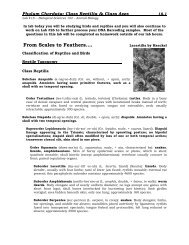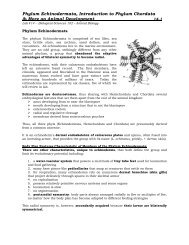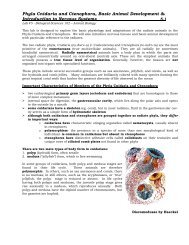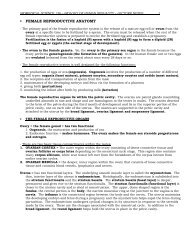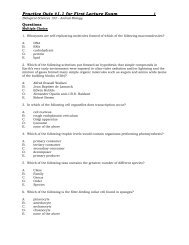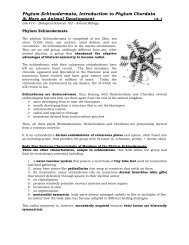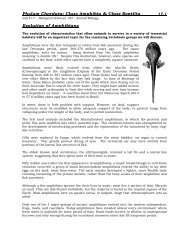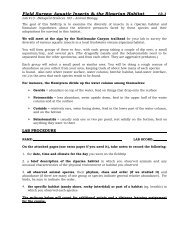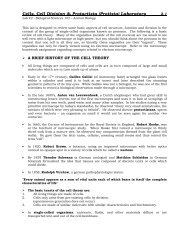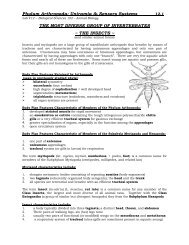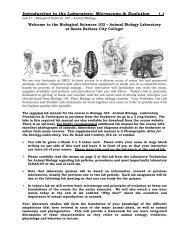Lab #9 - Phyla Onychophora & Arthropoda - Biosciweb.net
Lab #9 - Phyla Onychophora & Arthropoda - Biosciweb.net
Lab #9 - Phyla Onychophora & Arthropoda - Biosciweb.net
- No tags were found...
You also want an ePaper? Increase the reach of your titles
YUMPU automatically turns print PDFs into web optimized ePapers that Google loves.
Phylum <strong>Arthropoda</strong>: Subphyla Trilobita & Chelicerata andPhylum <strong>Onychophora</strong> & Respiratory Systems 9.3<strong>Lab</strong> <strong>#9</strong> -- Biological Sciences 102 – Animal BiologySPIDER CLASSIFICATIONClass ArachnidaOrder Araneae - SpidersTarantulas and Trapdoor SpidersFamily Theraphosidae - TarantulasFamily Ctenizidae - Trapdoor SpidersFamily Dipluridae - Funnel web Tarantulas"True spiders"Family Araneidae - Orb WeaversFamily Theridiidae - Cob web SpidersFamily Pholcidae - Cellar SpidersFamily Linyphiidae - Cup and Doily SpidersFamily Tetragnathidae - Long-jawed SpidersFamily Sicariidae - Recluse SpidersFamily Lycosidae - Wolf SpidersFamily Agenilidae - Grass SpidersFamily Oxiopidae - Lynx SpidersFamily Thomisidae - Crab SpidersFamily Salticidae - Jumping SpidersArachnida by Haeckel
Phylum <strong>Arthropoda</strong>: Subphyla Trilobita & Chelicerata andPhylum <strong>Onychophora</strong> & Respiratory Systems 9.5<strong>Lab</strong> <strong>#9</strong> -- Biological Sciences 102 – Animal BiologyLAB PROCEDURENAME:LAB SCORE:Refer to the textbook and Inter<strong>net</strong> for illustrations, diagrams, andadditional information about chelicerates.Phylum <strong>Onychophora</strong>Classification‣ Using the Inter<strong>net</strong> and/or your textbook, list some characteristics of the phylum<strong>Onychophora</strong>:‣ Observe one of the onychophorans on display in the lab.‣ Record the descriptive information requested at the end of the lab for this species.Observation of a Fossilized Trilobite SpecimenSubphylum Trilobita‣ Observe one of the trilobite fossils on display in the lab.‣ Record the descriptive information requested at the end ofthe lab for this species.Observation of Living SpecimensSubphylum ChelicerataClass MerostomataSubclass XiphosuridaGenus LimulusSpecies Limulus polyphemus (Horseshoe Crab)‣ Observe the specimens and/or diagrams of the horseshoe crab, Limulus sp.‣ Record the descriptive information requested at the end of the lab for this species.
Phylum <strong>Arthropoda</strong>: Subphyla Trilobita & Chelicerata andPhylum <strong>Onychophora</strong> & Respiratory Systems 9.6<strong>Lab</strong> <strong>#9</strong> -- Biological Sciences 102 – Animal BiologySubphylum ChelicerataClass Pycnogonida‣ Observe one of the specimens, diagrams and micrographs of a pycnogonid such asAmmothea hilgendorfi or Pycnogonum stearnsi‣ Record the descriptive information requested at the end of the lab for this species.Subphylum ChelicerataClass ArachnidaOrder Araneae‣ Observe one of the specimens and/or diagrams of a spider on display.‣ Record the descriptive information requested at the end of the lab for this species.‣ Using the Inter<strong>net</strong> and/or your textbook, answer the following spider relatedquestions.‣ What is the scientific name of the Black Widow Spider?‣ Are Black Widow Spiders found in California?‣ What are the symptoms of a Black Widow Spider bite?‣ What is the specific name of the group of protein neurotoxins injected by this species?‣ What is the scientific name of the Brown Recluse Spider (Violin Spider)?‣ Are Brown Recluse Spiders found in California?‣ What are the symptoms of a Brown Recluse Spider bite?‣ What kind of proteins cause the dermonecrotic arachnidism characteristic of thisspecies (why is the venom cytotoxic and hemolytic)?
Phylum <strong>Arthropoda</strong>: Subphyla Trilobita & Chelicerata andPhylum <strong>Onychophora</strong> & Respiratory Systems 9.8<strong>Lab</strong> <strong>#9</strong> -- Biological Sciences 102 – Animal BiologySPECIMEN STUDYClass MerostomataLimulus polyphemus (Horseshoe Crab)The horseshoe crab is found along the east coast of Asia (4 species) and the east coast of NorthAmerica (one species). They live partly buried in sandy or muddy bottoms, six to forty feetdeep, and move through the substrate feeding on polychaetes and bivalve mollusks. BetweenMay and mid-July they migrate toward shore and mate. Females lay eggs in depressions dugin the sand. Limulus is considered to be a primitive arthropod, little changed from ancestorswhich lived over 400 million years ago.Note: Do not dissect these specimens. Simply study them and then returnthem to their jars.Use a dissecting scope for your investigation.Obtain a specimen of Limulus and examine its dorsal surface. Locate the three main parts ofthe body, the prosoma (cephalothorax), the opisthosoma (the abdomen) and the telson(caudal spine). On the carapace of the prosoma locate the simple eyes, the median ridgedown the middle of the carapace, and the two compound eyes under lateral spines.‣ Examine the external anatomy of the horseshoe crab on both the dorsal andventral sides and be able to identify the following structures:Dorsal View‣ prosoma‣ opisthosoma‣ telson‣ simple eyes‣ compound eyes‣ median ridgeVentral View‣ chelicerae‣ walking legs‣ chelaria‣ book gills‣ genital operculum andopenings‣ anus‣ Are the walking legs of Limulus chelate?In adult male Limulus, the second pair of appendages is modified for clinging to theback of females during mating.‣ Is your Limulus specimen a male or female?The six appendages of the opisthosoma are broad, flat overlapping plates. The first is thegenital operculum, which has a line of flexion across it. Lift it to see the two genital papillae,containing the genital openings, near the center line. Lift one of the remaining fiveopisthosome appendages to see the gills laterally on their posterior surfaces. Each gill masscontains about 80 lamellae which have a tremendous surface area for respiration.Your instructor will be coming around to each group to assist you and ask you to identifythe structures listed in preparation for the invertebrate lab practical.‣ Return the Limulus to the container provided.‣ Rinse your dissecting tray and clean your supplies and return them.
Phylum <strong>Arthropoda</strong>: Subphyla Trilobita & Chelicerata andPhylum <strong>Onychophora</strong> & Respiratory Systems 9.10<strong>Lab</strong> <strong>#9</strong> -- Biological Sciences 102 – Animal BiologySPECIMEN STUDYClass ArachnidaOrder ScorpionidaScorpionNote: Do not dissect these specimens. Simply study them and then returnthem to their jars. Use a dissecting scope for your investigation.Obtain a scorpion specimen and examine its dorsal surface. One scorpion per two students.Pay particularly close attention to where on the body each limb articulates.Study the dorsal surface and locate the prosoma, from which the legs emerge, and theopisthosoma. The opisthosoma is divisible into the mesosoma (abdomen) and metasoma(segmented "tail"). On the carapace of the prosoma locate two groups of small eyes on theanterior-lateral edges, and two large eyes in the centerNotice the two claws on the last joint of the walking legs. The basal joints (coxae) of the firsttwo legs project inward as gnathobases, "jaws", which serve to crush food. Locate the genitaloperculum, the gonopore, and the two pectins (tactile organs). On the ventral surface of thefirst four mesosomal segments, locate the openings into the book lungs (diagonal slits on theventral surface of the first four mesosomal segments). The appendages of these four segmentslie within the slits. Each limb is modified into about 50 vascular leaves, which form part of thelung book which is used for respiration.The five segments of the metasoma lack appendages. The anus opens ventrally at the endof the fifth segment. Behind the fifth segment is the telson, which contains two poison glandsand bears a number of short sensory hairs. The poison glands open at the sides of the pointthrough tiny pores. Locate them under the dissecting microscope.‣ Examine the external anatomy of the scorpion on both the dorsal and ventralsides and be able to identify the following structures:Dorsal View‣ prosoma‣ opisthosoma‣ telson‣ small eyes‣ large eyes‣ pedipalps‣ chelaeVentral View‣ pectines‣ anus‣ book lung slits‣ chelicerae‣ gonopore‣ genital operculum‣ poison glands‣ What purpose do the pectines serve?Your instructor will be coming around to each group to assist you and ask you to identifythe structures listed in preparation for the invertebrate lab practical.‣ Return the scorpion to the container provided if it is still intact.‣ Rinse your dissecting tray and clean your supplies and return them.
Phylum <strong>Arthropoda</strong>: Subphyla Trilobita & Chelicerata andPhylum <strong>Onychophora</strong> & Respiratory Systems 9.11<strong>Lab</strong> <strong>#9</strong> -- Biological Sciences 102 – Animal Biology
Phylum <strong>Arthropoda</strong>: Subphyla Trilobita & Chelicerata andPhylum <strong>Onychophora</strong> & Respiratory Systems 9.12<strong>Lab</strong> <strong>#9</strong> -- Biological Sciences 102 – Animal BiologySPECIMEN STUDYClass ArachnidaOrder AraneaeArgiope aurantia (Garden Spider)The spiders are the most familiar arachnids. They are found in a variety of habitats and, as inthe case of all arachnids, prey on other small animals, especially insects. Many of them traptheir prey, while others hide and pounce on them. Miranda is the best known of the orbweavers and is highly effective in trapping flying insects.Note: Do not dissect these specimens. Simply study them and then returnthem to their jars. Use a dissecting scope for your investigation.Obtain a garden spider specimen, place it in a Petri dish and examine its dorsal surface.One spider per two students. Pay particularly close attention to where on the body eachlimb articulates.On the dorsal surface, note the body divisions: the prosoma (cephalothorax) and theopisthosoma (abdomen). On the front of the prosoma are two rows of eyes.On the ventral surface locate the small first pair of appendages, the chelicera, consisting oftwo segments. The second segment is the fang, which contains a poison gland. The secondpair of appendages are the pedipalps. These are followed by the four pair of walking legs.The ventral surface of the abdomen contains a transverse epigastric furrow which opens intothe book lungs. In front of this furrow is the gonopore. In females the epigynum lies in frontof the gonopore. More posterior on the ventral surface of the abdomen is the single trachealspiracle in front of the spinnerets. Finally, locate the anal lobe.Note that the four pair of walking legs articulate with the prosoma only, as the spinnerets arethe only abdominal appendages.‣ Examine the external anatomy of the garden spider on both the dorsal andventral sides and be able to identify the following structures:Dorsal View‣ prosoma‣ opisthosoma‣ eyes‣ walking legs‣ pedipalpsVentral View‣ chelicerae/fangs‣ epigastric furrow/epigynum‣ gonopore/genital opening‣ tracheal spiracle‣ spinnerets‣ How many eyes are there on the garden spider? (The location and number are oftaxonomic significance.)Your instructor will be coming around to each group to assist you and ask you to identifythe structures listed in preparation for the invertebrate lab practical.‣ Return the spider to the container provided if it is still intact.‣ Rinse your dissecting tray and clean your supplies and return them.
Phylum <strong>Arthropoda</strong>: Subphyla Trilobita & Chelicerata andPhylum <strong>Onychophora</strong> & Respiratory Systems 9.13<strong>Lab</strong> <strong>#9</strong> -- Biological Sciences 102 – Animal Biology
Phylum <strong>Arthropoda</strong>: Subphyla Trilobita & Chelicerata andPhylum <strong>Onychophora</strong> & Respiratory Systems 9.14<strong>Lab</strong> <strong>#9</strong> -- Biological Sciences 102 – Animal BiologyLiving Specimens DataPhylum <strong>Onychophora</strong>Scientific name:Common name:Notes & observations to help you remember and distinguish this group/species:Phylum <strong>Arthropoda</strong>Subphylum TrilobitaScientific name:Common name:Notes & observations to help you remember and distinguish this group/species:
Phylum <strong>Arthropoda</strong>: Subphyla Trilobita & Chelicerata andPhylum <strong>Onychophora</strong> & Respiratory Systems 9.15<strong>Lab</strong> <strong>#9</strong> -- Biological Sciences 102 – Animal BiologyPhylum <strong>Arthropoda</strong>Subphylum ChelicerataClass Merostomata (horseshoe crab)Scientific name:Common name:Notes & observations to help you remember and distinguish this group/species:Subphylum ChelicerataClass Pycnogonida (sea spiders)Scientific name:Common name:Notes & observations to help you remember and distinguish this group/species:Subphylum ChelicerataClass ArachnidaOrder Araneae (spiders)Scientific name:Common name:Notes & observations to help you remember and distinguish this group/species:
Phylum <strong>Arthropoda</strong>: Subphyla Trilobita & Chelicerata andPhylum <strong>Onychophora</strong> & Respiratory Systems 9.16<strong>Lab</strong> <strong>#9</strong> -- Biological Sciences 102 – Animal BiologySubphylum ChelicerataClass ArachnidaOrder Solifugae (sunscorpions and windscorpions)Scientific name:Common name:Notes & observations to help you remember and distinguish this group/species:Subphylum ChelicerataClass ArachnidaOrder Scorpionida (scorpions)Scientific name:Common name:Notes & observations to help you remember and distinguish this group/species:
Phylum <strong>Arthropoda</strong>: Subphyla Trilobita & Chelicerata andPhylum <strong>Onychophora</strong> & Respiratory Systems 9.17<strong>Lab</strong> <strong>#9</strong> -- Biological Sciences 102 – Animal BiologySubphylum ChelicerataClass ArachnidaOrder Acari (ticks & mites)Scientific name:Common name: TickNotes & observations to help you remember and distinguish this group/species:Subphylum ChelicerataClass ArachnidaOrder Acari (ticks & mites)Scientific name:Common name: MiteNotes & observations to help you remember and distinguish this group/species:
Phylum <strong>Arthropoda</strong>: Subphyla Trilobita & Chelicerata andPhylum <strong>Onychophora</strong> & Respiratory Systems 9.18<strong>Lab</strong> <strong>#9</strong> -- Biological Sciences 102 – Animal BiologySubphylum ChelicerataClass ArachnidaOrder Pseudoscorpiones (pseudoscorpions) – if availableScientific name:Common name:Notes & observations to help you remember and distinguish this group/species:Subphylum ChelicerataClass ArachnidaOrder Opiliones (harvestmen) – if availableScientific name:Common name:Notes & observations to help you remember and distinguish this group/species:LABORATORY NOTES:



